In sub-professionals, analog circuits are a very important lesson, and many people find it difficult. This article will talk about the understanding of the analog circuit, I hope to be helpful to everyone.
Engineering thinking
If I say test scores, my test scores are average, not high scores; but when it comes to the understanding and application of analog circuits, I have done some things with analog circuits and participated in some competitions. The analog circuit is an engineering course. The key to learning it is to master the engineering ideas, and it is best to use it in practice, not just to do the exam.
What is engineering thinking? Baidu Encyclopedia's explanation is this:
Engineering is an application of science and mathematics. Through this application, the material and energy properties of nature can be made through various structures, machines, products, systems and processes, with the shortest time and fine manpower. An efficient, reliable, and useful thing for humans. So the concept of engineering came into being, and it gradually developed into an independent discipline and skill.
For example, in analog circuits, there is a very important engineering idea - approximation. In the middle school physics class, many of the circuits we learned are ideal circuits. The wire resistance is always 0, the efficiency of the transformer is 100%, the internal resistance of the ideal voltmeter is infinite, and the internal resistance of the ideal ammeter is 0. You can see that many times the calculations in analog circuits often omit one or two smaller items and use the equal sign instead of the equal sign.
Why use an approximation? To put it bluntly, human science's understanding of nature is not comprehensive enough to describe natural phenomena absolutely or accurately; or humans have limited understanding and accurate descriptions are too costly. By approximating means, not only has no obvious effect on solving the problem, but also greatly simplifies the steps, saving time and effort. Using this idea, human science has achieved many results and fully proved its reliability.
2. Summary
Modular electricity itself is a very complex subject, and the modular electricity course is only the most basic one. The meaning of an analog circuit is an electronic circuit that processes an analog signal. Most of the signals in nature are analog signals, which have continuous amplitude values, such as the sound signal when speaking. The analog circuit can directly process such a signal (of course, it needs to be converted into an electrical signal first), for example, the power amplifier can amplify the sound signal, and the broadcast station can transmit the analog sound signal and the image signal. It can even be assumed that the basis of all circuits is analog circuits (even digital circuits, the underlying principle is based on analog circuits). Its importance is self-evident.
Due to the rapid development of digital circuits and programmable devices, many superior features have been demonstrated. Many electronic devices are slowly digitized, but they are still inseparable from analog circuits.
The most important devices in analog circuits today are non-semiconductor devices. The most basic and commonly used semiconductor devices are diodes, transistors, field effect transistors, and operational amplifiers.
Diodes have many functions, such as ordinary diodes for rectification, LEDs for indicators and illumination, Zener diodes for voltage regulation, and varactors for signal modulation. In the model electricity course, the part related to the diode is relatively simple, and many characteristics of the field effect tube are similar to the triode, so the triode or op amp is often used as the main body to explain.
3. Transistor and amplifier
The basic function of the triode is to amplify. Through this characteristic, the triode constitutes various circuits, which reflects many engineering ideas.
The basic circuit of a triode is an amplifier. For example, a power amplifier is an amplifier, and the input sound is small, and the output sound is large. The ratio of the output of the amplifier to the input voltage (or current) is called the amplification factor, also known as the gain.
For a voltage, if the time is plotted on the horizontal axis and the voltage is plotted on the vertical axis, this graph is the waveform of this voltage.
If a amplifier with a magnification of 5 inputs a constant 1V voltage (the waveform is shown below), the output should always be 5V (the waveform is shown below), neither changing with time nor changing with temperature, output It is exactly the same shape as the input voltage. However, if the magnification is unstable and constantly changing, the originally input signal will be distorted (as shown in the right figure below), and the signal may be changed from a horizontal line to a curve. This waveform change is called distortion.
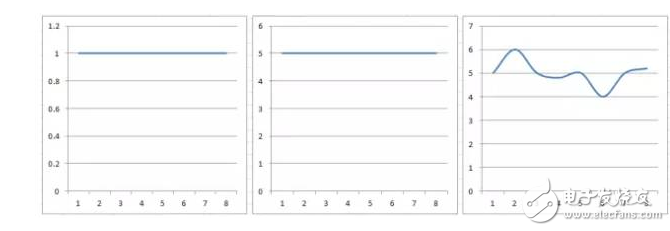
An ideal amplifier, hopefully its magnification is a constant value. If the amplifier's magnification is unstable, the sound will be louder and smaller, and the waveform change will also cause the sound to change, that is, distortion.
Reality is always contrary to ideals. Unfortunately, the characteristics of the triode are not ideal. When operating in an amplifying circuit, the amplification factor is not only affected by the input voltage, the power supply voltage, but also the temperature change caused by self-heating, which also affects its amplification factor. This is really a headache for many engineers. If you can't find an effective way to reduce the impact of this feature, the triode is difficult to apply to the real world.
4. Negative feedback
So some very powerful people found a good way: negative feedback. What is negative feedback?
Feedback means that the output of the system is returned to the input and affects the input, thus affecting the overall output of the system. Feedback can be divided into positive feedback and negative feedback. Negative feedback is to make the output act in the opposite direction to the input, making the system output stable.
The above explanation is not easy to understand. I will give two examples.
1. When playing the inverted pendulum, we support an inverted wooden stick by hand. When the wooden stick is tilted in a certain direction, we counteract this change by moving the hand to the direction in which the stick is tilted, so that the stick can Balance on hand.
2. When I was in high school, I often took the monthly test. I found that some students have such a habit: when a grade is poorly tested, they will start to study hard, and then the next grade will rise. When the test is better, then One month will be relaxed, so the results will fall again, so it will be repeated.
Both examples fully demonstrate that negative feedback can make the system more stable.
Negative feedback amplifier
We ignore the specific circuit and just draw a simple block diagram to illustrate how the triode amplifier circuit uses negative feedback.
The triangle below represents an amplifier consisting of a triode with a magnification of A and an input of I. The output is O=A*I. Since the amplification factor A is unstable, the output waveform is distorted.
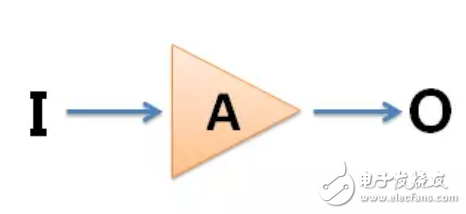
Some devices have been added to the circuit as follows.
The purple circle is an adder, combined with the purple "+" and "-" symbols, indicating that its output Y = (+I) + (-X) = IX, which can be realized with a resistor in the actual circuit;
Block F is a feedback device that indicates that the signal is taken from output O and multiplied by F to obtain X, so X = 0 * F, where F < 1 (this part can be implemented with a resistor in the actual circuit);
The amplifier A represented by a triangle is mainly composed of a triode, which satisfies O=A*Y, and the amplification factor of A is unstable and is easily disturbed.
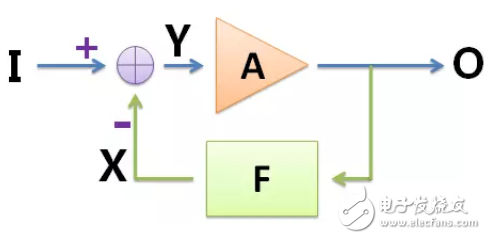
You can list the equations:

Solve the magnification of the entire circuit:

If the design circuit makes the magnification A very large and F is not too small, then

The symbol ">>" means much larger than
According to the approximate idea, the above circuit magnification:
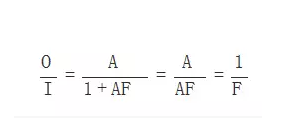
Since the feedback device can be realized by a resistor, the resistance of the ordinary resistor is not easily disturbed by the outside, so the value of F is stable, and the amplification factor of the entire circuit is stable. We successfully solved the problem of the amplification stability of the triode through negative feedback.
It can be seen that the feedback part and the amplifying part here constitute a ring shape, so the amplification factor of the whole circuit is called loop gain, or closed loop gain; and before the feedback is added, the amplification factor A of the circuit is called open loop gain. Due to the negative feedback, although the gain stability of the circuit is improved, there is also a price:

then
A>>1/F
That is, the open loop gain is much larger than the closed loop gain, that is, the amplifier gain is greatly reduced. But in general, for stability, this is worth it.
5. Operational amplifier
In the above circuit, in order to actually manufacture an amplifier having a large open-loop gain A, it is often designed in a multi-stage triode amplification circuit in series. Since the demand for such high-gain amplifiers is very common, some people have historically made them into a finished circuit board module, which is very convenient when used as a component. This is the original operational amplifier, referred to as the op amp.
The development of integrated circuits has made it possible to integrate a large number of transistor components on a small chip, so there is an integrated operational amplifier that is very commonly used today.
The "Operational Amplifier" is named for its initial use in mathematical operations on analog computers. Although the digital computers that are widely used today no longer use the op amp for calculations, the name is retained. Today, the operation of the analog circuit plays a very important role, and has become one of the focuses of the model.
6. The virtual short and short break characteristics of the op amp
Usually the op amp has two inputs U+ and U− and one output Uo, which meets between them.

The open-loop gain A of the op amp often ranges from several hundred thousand to several million, but the output voltage of the op amp is limited by the supply voltage and cannot exceed the supply voltage. The input-output relationship of the op amp is then similar to the shape of the figure below.
The horizontal axis in the figure is 
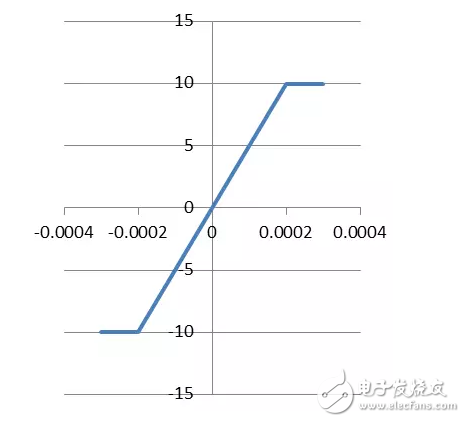
In the middle of the straight line area, the normal amplification state, called the linear area, is satisfied.
Uo=A∗(U+−U−)
When the absolute value of the input is slightly larger, the output will be limited by the power supply, and the above relationship will no longer be satisfied. The value of Uo is usually slightly smaller than the power supply voltage range (note that the op amp can use dual power supply, that is, the power supply voltage range can be A negative value and a positive value are called nonlinear regions.
The output of the rail-to-rail op amp can reach the power supply voltage, and you are interested in searching and learning online.
When the op amp is operating in the linear region, the value of Uo is very limited, but A is large, so U+−U−=UoA≈0
U+≈U−
At this point, the positive and negative input voltages of the op amp are almost equal, just like a short circuit, called virtual short. Therefore, only when the op amp works in the zoom-in area will it have the characteristics of “virtual shortâ€, not the inherent properties of the op amp.
On the other hand, due to the internal structural characteristics of the op amp, its input impedance is large.
Input impedance can be simply understood as input impedance = input voltage / input current
The large input impedance means that the op amp input requires only a small amount of current to operate properly. Because of this, the op amp can be used for the detection of some weak currents, such as the brainwaves and myoelectric waves of the human body. The highest voltage value is only a few mV, and the current value is also very small.
This feature of the op amp is called a virtual break, that is, the input is the same as the open circuit, and almost no current flows in.
Unlike virtual shorts, virtual breaks are inherent properties of the op amp and do not change with the circuit.
7. Non-ideal characteristics of the op amp
The op amp consists of a triode, and obviously, like a triode, there are many undesirable characteristics. All of the above are the characteristics of an ideal op amp. The actual op amp, it will not fully meet the virtual short-short characteristics, the input requires current flow in normal operation, this current is called the input bias current. The same op amp also has non-ideal parameters such as input bias voltage, input offset voltage, and input offset current.
These non-ideal characteristics, such as the input bias current, are small, but sometimes they have a large impact on the circuit, making the circuit inoperable. Therefore, there are some ways to reduce the impact of these factors. In practical applications, the non-ideal nature of the op amp is a very important issue. There are many ways to eliminate the non-ideal characteristics of an op amp, which will not be introduced here.
8. Other content
The core of the model is the triode and op amp. Around these devices, explain a variety of circuits, including:
â— Calculation and analysis of the amplification circuit, multi-stage amplification circuit, frequency characteristics of the amplifier, and feedback ideas;
â— power amplifier circuit;
â— comparator, oscillator, integrator, differentiator, waveform generation, etc.;
â— Signal operation processing;
â—Filter;
â— Integrated regulated power supply circuit, etc.
9. Comparison of op amps and triodes
When actually designing the circuit, the op amp is more used than the triode. Because many of the characteristics of the op amp are better than the triode, the circuit design is simple, and the cost of the op amp is often not high. Many times the same effect is achieved with a triode and an op amp, and the cost of using an op amp is even lower. Because op amps integrate a large number of transistors, the average manufacturing cost per transistor is very low.
For example, a conventional audio preamplifier, a general-purpose op amp can be fixed, the cost may be 0.2 yuan, and the same effect can be achieved with a triode, which may require 10 or more triodes, the cost may be 0.5 yuan, and the design cost The labor cost is much higher than the op amp solution.
Of course, the triode also has its advantages. In some very simple circuits, the stability of the magnification is not strictly required. One or two transistors can accomplish the task, and the triode is often used to save costs. In addition, under some extreme conditions, such as working in high frequency, high power environment (such as RF signal transmission circuit), the performance of well-designed triode circuit will be much better than the op amp, or the cost is much lower, and even some In this case, only the transistor can be used directly. In this case, a triode is needed to build the circuit.
10. End
The introduction of the model electricity course ends here. But what I want to say is that analog circuits are a very complex subject, and the knowledge involved is much more than just those in the book. The book is generally introduced according to the working principle, which simplifies many problems that are difficult to understand but must be considered in practice, so the gap between the actual circuit and the book is very large. For example, a triangular wave generator built by an op amp in a mold book is used for practical circuits. However, the main principles of the actual circuit are consistent with the description in the book. Therefore, designing analog circuits often requires a lot of experience, and there are many things that are even difficult to explain and cannot be calculated.
Capacitor for Electric Furnace
Capacitor for Electric Furnace, commonly referred to as capacitors, are capacitors, expressed in the letter C.Definition 1: a capacitor, as the name implies, is a "charging vessel", a device that holds charge.Capacitor.Capacitors are one of the most widely used electronic components in electronic equipment. They are widely used in the fields of interleaving, coupling, bypass, filtering, tuning circuit, energy conversion and control.Definition 2: a capacitor consisting of any two conductors (including wires) that are insulated from each other and are very close together.
Electronic Components Capacitors,High Voltage Capacitors,Low Frequency Capacitor,Water Pump Capacitor,Capacitor for Electric Furnace
YANGZHOU POSITIONING TECH CO., LTD , https://www.yzpstcc.com